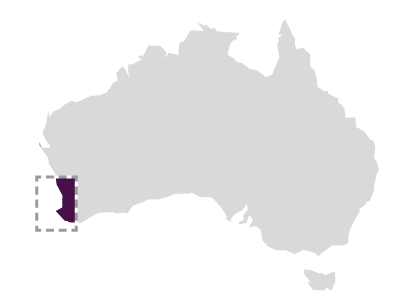Coolgardie (1937/02/10)
Caple Beach (Roses Beach) 14 miles S Bunbury 2 miles N Caple River

Coolgardie was built in Fremantle by William Alexander Chamberlain, assisted by a man named Sweetman. It had a straight stem and a counter stern. Launched in January 1896 the vessel was not registered until 20 October 1902. Coolgardie was used in the pearling industry in the north-west of Western Australia for many years with the registration number B146. An owner who had used it in 1897 for pearling was Sweetman’s son, F.J. Sweetman. It was still involved in the pearling industry in 1913, but there is little information on the years between 1913 and 1937. In that year the Coolgardie was owned by Mrs May Robinson of Claremont, and had been leased by Frank Casparson for two years. The schooner left Fremantle on 25 January 1937 on a fishing expedition to Cape Leeuwin, and was expected to return in 14-15 days’ time. There was a three weeks’ supply of food and ice on board. The crew consisted of the skipper, Frank Casparson (39), Martin Martinsen (65) and Robert Sharpen (about 45). At the time of its loss the Coolgardie was 41 years old, which is a remarkable age for a small vessel which had had a hard working life. Its builder, Chamberlain, had a high reputation for workmanship and in this case it must have been well deserved.
A cyclone, described as one of the worst on this part of the coast in over 80 years, struck the area where the Coolgardie was last sighted at about 6.00 p.m. on 10 February 1937.
THE LOSS
On 13 February Mrs Casparson reported to the police at Fremantle that the Coolgardie was four or five days overdue. Initially the boat and crew were not listed as missing, but when there was no sight of vessel or crew a few days later, enquiries commenced. The Coolgardie had last been seen when it was fishing in company with the Swansea (Charles Axel, skipper) off Cape Bouvard on Wednesday 10 February. Around 3.00 or 4 .00 p.m. Axel noticed a storm advancing from the north and headed to Bunbury for shelter. His last sighting of the Coolgardie was to see it attempting to beat into the wind towards Fremantle.
Commencing on 18 February the newspapers were reporting that police from Yarloop, Harvey, Bunbury, Busselton, Margaret River and Albany were patrolling the coastline searching for the missing schooner and its crew, and one reported that ‘all hope has been abandoned for the fishing lugger Coolgardie, which left Fremantle on January 25 and is feared to have foundered in the recent storm’ (Daily News, 25 February 1937: 7f).
However on 24 February Joseph Strong and Jack Richardson reported the finding of part of a cabin top on the beach 14 miles south of Bunbury and 2 miles north of the Capel River to Sergeant Molloy at the Busselton Police Station. After examining the section of wreckage and the compass which had been attached to it, Sergeant Molloy began enquiries. Initially it was presumed to be off the fishing boat Wattle, which had lost its cabin when it was wrecked at the Busselton Jetty in the cyclone two weeks previously (see section). However the Wattle’s owner said it was not the cabin off his boat. Further investigation proved it to be part of the cabin off the Coolgardie. It was made of jarrah, painted white inside and dark green on the outside, and measured some 1.83 m square and about 66 cm deep. There were three rectangular porthole openings which had been boarded over, and a mast hole in the centre 20 cm in diameter. Molloy’s informants were Frederick Rodriguez and Martin Rolda, both of whom had previously worked on the Coolgardie, and knew it well. A thorough search of the coast for many miles found no other wreckage associated with the missing schooner.
In his report to his inspector Sergeant Molloy stated: ‘fisherman and others informed me that the cabin may have floated a long distance before reaching Capel’ (SRO 430 Item 942/1937). He also added that he had been told that the Coolgardie was heavily ballasted and old, and would have sunk very quickly when the cabin gave way.
INITIAL SALVAGE
The police at Fremantle returned the compass off the Coolgardie to Mrs Robinson, owner of the schooner.
SITE LOCATION
Divers from the Western Australian Museum in May 1995 carried out a wreck inspection on a wreck on Bouvard Reef and speculated that the material may have come from either the Bee or the Lass of Geraldton, both lost in this vicinity. The GPS position of the site inspected is 32° 50.492 S and 115° 35.166 E, almost ten miles south of Cape Bouvard. This site seems to fit best with that of either the wreck of the Comet or the Coolgardie, as it is some distance offshore. It has subsequently been found that the Bee was wrecked on the beach.
A small specimen of timber from the site was identified by Dr Ian Godfrey, Western Australian Museum, as being a Eucalyptus species, possibly jarrah or karri. This would seem to indicate a locally built vessel, such as the Coolgardie. The Lass of Geraldton was constructed of timber recovered from the wreck of the African, an English-built ship.
Ship Built
Port Built Fremantle
Port Registered Fremantle
When Built 1896
Ship Lost
Grouped Region South-West-Coast
When Lost 1937/02/10
Where Lost Caple Beach (Roses Beach) 14 miles S Bunbury 2 miles N Caple River
Port From Fremantle
Port To Cape Leeuwin
Ship Details
Length 10.80
Beam 3.40
TONA 14.53
TONB 11.22
Draft 0.98
Museum Reference
Official Number 114484
Unique Number 1102
Chart Number Aus 775, Aus 116 & WA 755
Protected Protected Federal
Found N
Confidential NO